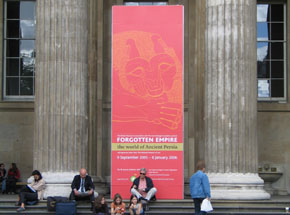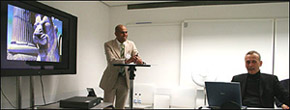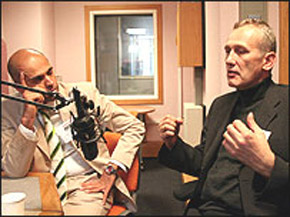
VIRTUAL RECONSTRUCTION OF PERSEPOLIS BY TWO ARCHITECTS
BBC Persian.com (Oct. 4, 2005)
By: Mehdi Jami, Translation: Sheda Vasseghi
The production of a second long documentary movie of Persepolis using the art of digital visualization is a sign of its importance and interest in using the computer technology to bring ancient sites to life.
In less than a year from introduction and release of the film Persepolis Recreated, another film about this historical ruin but still majestic from the ancient times has been brought to the movie screen.
The film which is simply entitled Persepolis is the work of ARTE Television, a government-owned television station shared by Germany and France.
Contrary to the film Persepolis Recreated produced by Farzin Rezaeian, Persepolis is a work by different authors .
Kourosh Afhami says that about four years ago he and his German partner Wolfgang Gambke began the project of reconstructing Persepolis in its entirety. Two years later, they launched a website making their first graphics available to the public. At this time, Goetz Balonier from ARTE Television, who had a project regarding Persepolis at hand, discovered their work on the internet and contacted them for collaboration.
The result of this collaboration in the form of a 60-minute movie was shown at the World of Achaemenid conference at the British Museum. It is a well-made movie with beautiful cinematography that contains 12 minutes of the Afhami-Gambke virtual reconstruction images .
Reconstruction From an Architectural Point of View
Both Kourosh Afhami and Wolfgang Gambke are experienced architects . As architects , they are familiar with digital modeling of buildings . But digital visualization of Persepolis which is a very ambitious project is their first project on ancient sites .
Afhami has been researching Persepolis for 20 years and in this project, he brings his indepth knowledge of Persepolis while Gambke’s focus is mainly technical reconstruction.
“He contributed his expertise in computers to this project and I brought my knowledge of the architecture of Persepolis . Our focus is different but the project is a by-product of both our efforts .”
In the film Persepolis , they are responsible for the reconstruction and animations both inside and around the palaces of Persepolis . All the onsite areas in the film that change to animation were filmed with Gambke’s consultation.
The reconstructions of Afhami-Gambke mainly rely on an architect’s point of view. Although Afhami has thoroughly researched the archeological records of Persepolis -- mainly according to German Near Eastern historians -- in reconstruction, they also used their own experience as architects to choose between contradicting versions when necessary.
The film Persepolis is seen from a social and an architectural point of view that is contrary to the Persepolis Recreated film which mostly leans on interviews with archaeologists .
Stone Interpretation
Afhami-Gambke has a understanding of Persepolis which leans more on an architectural rather than archaeological point of view.
They bring this topic to light which is obvious , yet rarely discussed, that compares Persepolis to previous buildings before its time in an interpretation from an architectural point of view.
At a glance, Persepolis has many similarities to the architecture of Babylonia and Assyria. The same people, soldiers , kings with the same long beards and sitting style on the throne or wearing ornamental jewels ; the same structures and familiar engravings prior to the Achaemenids .
But they touch upon a point that is the most Iranian element in Achaemenid architecture. Persepolis is not a scary or frightening architecture; it is an inviting and unifying structure:
“Persepolis was built to show the character of a global government to the people. It had to show the imperial power of the Achaemenids the same way the Babylonians and the Assyrians showed through their architecture. But in Persepolis , the architecture does not instill fear but instead, it shows splendor and grandeur; it is inviting.”
This soft smile and Buddha-like engravings of the Achaemenid men, this happiness and calm personalities is a element:
“If you compare the faces and reliefs of Persepolis to the Babylonian and the Assyrian engravings , you will see that it is very calm, and gentle and spiritual.”
“Even in the images that are supposed to be aggressive, for example, the one where the king/hero is wrestling with an imagined beast, you see calm expressions and there is no need to worry.”
During the interview with the two of them regarding the challenges of this reconstruction, Gambke saw it as this same calmness :
“The thing that is seen everywhere in Persepolis is a very calm spirit and the desire for peace that is seen in all the faces of the engravings including the bull capital heads .”
“The main difficulty in digitally reconstructing Persepolis was in creating and showing the same feeling in our work. Reconstructing these figures was the most difficult task. Something you don’t see in Greek architecture.”
He sees this peace as the spirit of the architecture of Persepolis -- it’s a peace symbolic of brotherhood that is clearly obvious in the hands that hold flowers or rest on the shoulders of companions or hold hands in friendship.
Combination, an Iranian Art
During his presentation at the World of Achaemenid conference, Afhami categorized Persepolis as one of the Ancient Wonders of the World. But what was in this architecture that should place it among the ancient wonders ?
“The wonders of ancient architecture were based on the budget that was required to build the site and innovative methods in construction and also its dimensions should be considered as a wonder.”
He used the Temple of Artemis in Ephesus as an example. In comparing the two:
“The distance between the columns at Persepolis is 3 meters longer and this is while the columns are 1.5 meters taller and thinner than the columns that existed prior to Persepolis . Even though Persepolis was built only 20-30 years after Temple of Artemis , in the techniques of roofing and column-setting, it was a giant leap forward.”
But if the spirit of Persepolis is peaceful, its main architectural element is the combination: “Persepolis is a combination of different techniques from its own time but it was built with an innovative architectural view point that resulted in the creation of something never seen in its time again.”
“This combination of techniques gave Persepolis its character and this was also an Achaemenid political concept which opened its arms to various cultures in order to manage a vast and diverse empire.”
But were there any influences from this architecture that were passed on to subsequent Iranian architecture?
“The Persepolis architecture was an imperial and governing architecture and its builders were the Achaemenids . That’s why its progress ceased with the fall of the Achaemenids . Nevertheless , some characteristics survived such as the battlements which were incorporated in later Iranian architecture.”
“A Conference is Necessary for All Aspects of Reconstruction.”
That sense of spirituality and peace further supports the idea that Persepolis was a spiritual place rather than a political place or acted as a capital for the Achaemenids .
Shahrokh Razmjou, a young Iranian archaeologist whose work and opinions are also introduced in the film Persepolis , showed rather skillfully that there may be different interpretations of the buildings in Persepolis .
He believes that the buildings in Persepolis are not royal palaces as they have typically been represented, and therefore, it is incorrect to consider them as royal residences . He too believes that Persepolis was a spiritual place.
In his opinion, the spirit of happiness and calmness at Persepolis is more prominent than anything else. According to him, happiness was one of the basic Achaemenid beliefs because it was also the Fourth Creation from the Creations of Ahura Mazda.
He believes Persepolis was to transmit happiness and peace that in its own way was a sign of a power that was established and stable and confident.
Razmjou believes that in reconstruction of Persepolis , there is a need for collaboration with experienced architects who are familiar with ancient art and archeology. He said that so far such an ideal partnership has not been achieved.
His recommendation for reconstructing Persepolis is that there should be a conference during which different views can be analyzed and discussed such as the way the windows were built and the use of color schemes .
Color scheme was one of the areas in question for the Afhami-Gambke work. Dr. Ehsan Yarshater believed the colors were too bright. Many others were in agreement with him. Also the topic of proportions was an issue that was brought up by Muhammad Hassan Talebian, the head of the Pasagadae project.
Although Afhami agrees that colors can still be adjusted, he defends his work in connection with proportions :
“Our work was based on the research materials of two highly-regarded German archaeologists Schmidt and Krefter. They calculated with precision all sizes of the buildings and the columns and we followed those measurements to the millimeter in our reconstructions .”
The Afhami-Gambke work is still a work in progress . They say the images and animations put in the film Persepolis was not the end of their work, and they are continuing with the completion of the visualization of Persepolis and will regularly update their website with images and one-minute video clips .
Their main goal is for the result of their work to be used in prominent museums around the world. They say the relics in the museums are shown alone: “We want to place these objects in their appropriate context and bring them to the Achaemenid time.”
Grandeur and Poetic
Although Persepolis Recreated moves towards creating an atmosphere and for its story uses the dramatic and epic elements , Persepolis is based on architecture without dramatic elements .
If Farzin Rezaeian’s work continues , it can be in the form of a fully-digitalized movie that shows the life of the kings and nobles of Achaemenids and the various celebrations that were held at this spiritual site.
But the Afhami-Gambke work is based on an obsession for architectural precision in virtual reconstructions of Persepolis with a unique insight regarding the importance of the spirituality of Persepolis .
It seems that future work cannot be without this attention to detail – so that each palace is reconstructed according to its own facts -- or without dramatic elements . The life that was in Persepolis and its subsequent destruction are worthy of amazing theatrics .
In comparing the two films , Shahrokh Razmjou says that Persepolis Recreated showed the grandeur of the Achaemenids and Persepolis had a poetic and spiritual sense. Undoubtedly, reality was a combination of the two.
This film will be shown in French and German on ARTE Television in the month of January, 2006.



home
statement
structures
film
service
shop
project developers copyright
notice
update info
friedrich krefter
nouruz 2005
pasargard
news
links
email
